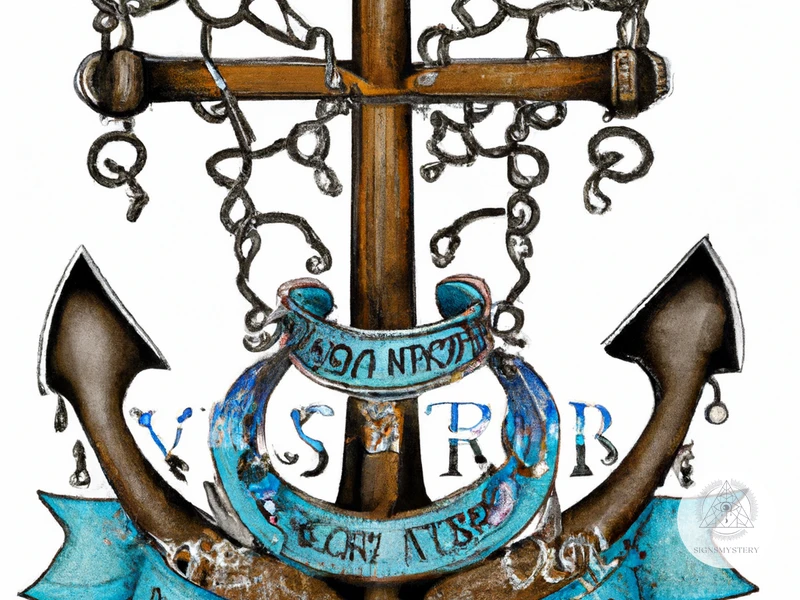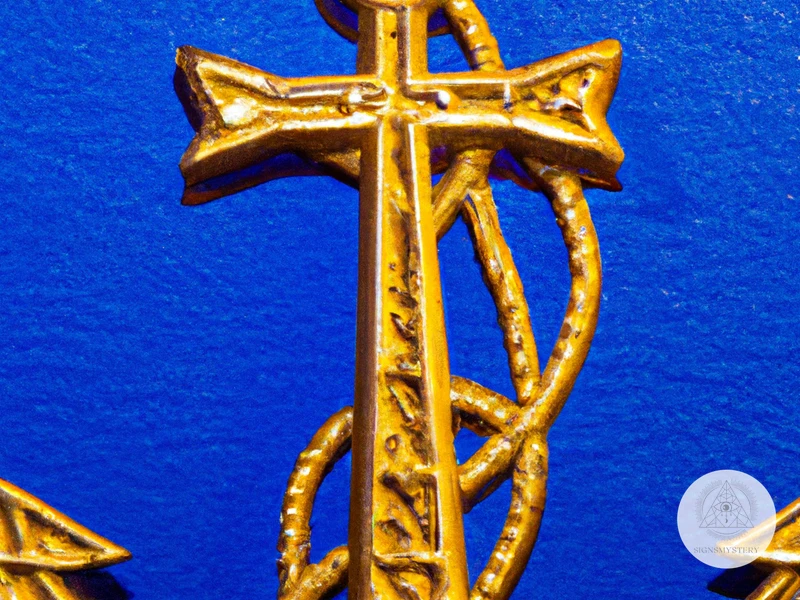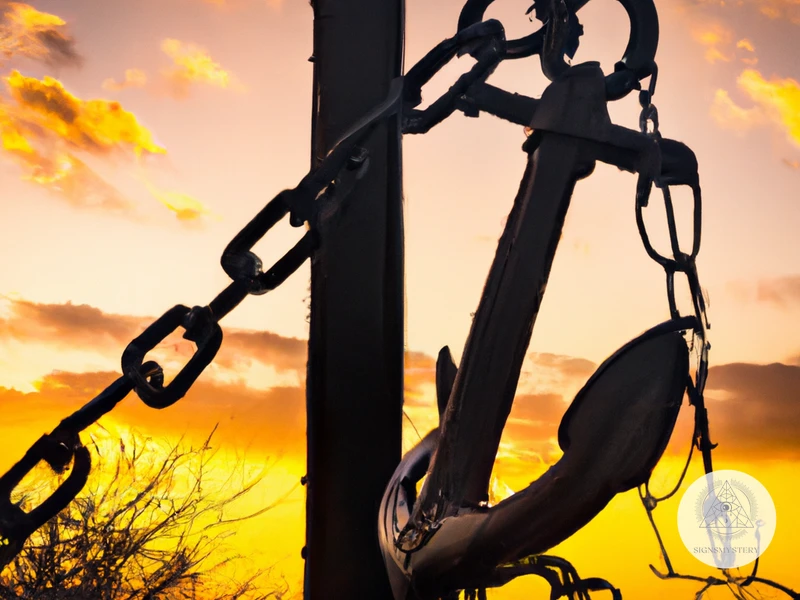The anchor is a common symbol with a rich history in Christianity. It has been used for centuries as a representation of steadfastness, hope, and salvation. Beyond its physical use in securing ships, the anchor has taken on a deeper spiritual meaning that is reflected in Christian art, traditions, and ceremonies. In this article, we will explore the various interpretations and examples of the anchor in Christian faith, as well as its intriguing origins and use throughout history. Join us on this journey of discovery and uncover the symbolism of the anchor in a new light.
History of the Anchor Symbol

The history of the anchor symbol can be traced back to ancient times, where it was used as an essential tool for navigation by sailors and fishermen. The symbol was later adopted by early Christians as a representation of their faith and hope in Jesus Christ. In Christian faith, the anchor symbolizes stability, hope, and safety in times of tumult and hardship, and this is why it became a prevalent theme in Christian art and architecture. The use of symbols in Christianity is not uncommon, as they serve as visual representations of complex concepts and beliefs. Thus, the anchor symbol has endured for over two millennia, along with other popular Christian symbols such as the cross, ichthus, the Holy Spirit dove, and the alpha and omega symbols, which continue to be celebrated in modern Christianity.
Origins in Ancient Times
The use of anchor as a symbol dates back to ancient times, long before the inception of Christianity. The anchor was a popular symbol among sailors across various cultures, as it served as a representation of their professions and was a crucial tool for keeping their ships and boats anchored in place in the open seas.
In Greek mythology, the god of the sea, Poseidon, used an anchor as his scepter, which signifies the stability of the sea. The Romans, too, adopted the use of the anchor as a symbol and used it as a representation of their maritime power.
The use of anchor as a symbol goes beyond the realms of religion and mythology and found its way into philosophy as well. In ancient Stoic philosophy, the anchor was seen as a symbol of hope, and was often used as an analogy for how the individual can find stability and strength in turbulent times.
The adoption of the anchor symbol by Christianity came much later, but the ancient origins of this symbol are undoubtedly fascinating. The use of symbols was widespread across civilizations, and it is remarkable how they have withstood the test of time and continue to inspire and evoke meaning even today.
Adoption by Early Christians
The anchor symbol was adopted by early Christians as a way to secretly express their commitment to Christianity during a time when it was illegal and punishable by death. The anchor was chosen as a symbol because it was commonly used by sailors, and many Christians of the time were fishermen or sailors themselves. The anchor provided a way for Christians to show their faith discreetly while avoiding persecution. The symbol was often inscribed on catacomb walls, used on tombs or jewelry, and depicted in Christian art. The use of the anchor by early Christians shows the creativity and resourcefulness of the Christian community in finding ways to express their faith in a dangerous and hostile environment. Today, the anchor symbol continues to be a powerful reminder of this period in Christian history and the bravery of early Christians.
Meaning and Interpretations
The anchor symbol has long been adopted by Christians and is often seen in Christian art and architecture. The anchor has a multitude of meanings and interpretations, including representing hope and trust in God, steadfastness, stability, navigation, and salvation. In early Christianity, the anchor symbol was used as a covert symbol to represent the cross, much like the ichthys fish, and the Holy Spirit dove symbols. The anchor is a powerful symbol of Christian faith, reminding us to remain steadfast and trust in God’s protection, even in turbulent times.
Hope and Trust in God
Hope and trust in God are fundamental values of the Christian faith. In times of struggle and challenges, the anchor symbol serves as a reminder to the faithful to place their hope and trust in God. This is derived from the literal meaning of the anchor as a device used to keep a ship steady in times of storm or turbulence. In the same way, God’s love and grace act as anchors for believers, keeping them steadfast in the face of life’s challenges.
The anchor also represents the hope that Christians have in the eternal life promised by Jesus Christ. Hebrews 6:19-20 states that “We have this hope as an anchor for the soul, firm and secure. It enters the inner sanctuary behind the curtain, where our forerunner, Jesus, has entered on our behalf.” Similarly, Psalms 62:5 reminds us to “find rest, O my soul, in God alone; my hope comes from him.”
Throughout history, the anchor symbol has been a source of comfort for Christians facing hardship and persecution. St. Clement of Alexandria wrote in the 2nd century that “our Lord is the true, holy, and steadfast anchor” and he urged Christians to “cling to him with all their might.” The anchor symbolizes the assurance of salvation that Christians receive through their faith in Jesus Christ.
The Ichthus symbol also represents hope and trust in God as it is often used as a secret sign among early persecuted Christians. The symbol was used as a way for believers to identify each other, indicating that they shared the same faith and hope in God. Additionally, the Alpha and Omega symbol represents the hope and trust in God as the beginning and the end, emphasizing that God is the source of all hope and that His promises will be fulfilled.
Steadfastness and Stability
Many people associate the anchor with the concept of steadfastness and stability. In fact, the anchor’s primary function is to prevent a ship from drifting aimlessly, and this is where the symbolism of steadfastness comes from. To be steadfast is to remain fixed in one spot, without wavering or being swayed by external forces. This is something that Christians value highly, as they believe that faith in God provides a solid foundation upon which to build their lives.
Stability is another important concept associated with the anchor. When a ship is anchored, it is firmly secured to the sea bed, providing a stable platform from which to operate. This stability is essential for a vessel to remain upright in turbulent waters. In the same way, Christians believe that their faith in God provides them with stability and helps them to weather life’s storms. They trust that God will provide a firm foundation for their lives that cannot be shaken, no matter what challenges come their way.
The concept of steadfastness and stability is also closely linked to the idea of endurance. Just as a ship’s anchor helps it to endure rough waters, so too does faith in God help Christians to endure the challenges of life. The Bible is full of stories of faithful men and women who endured great trials and tribulations. They were able to do so because of their steadfastness and their unshakable belief in God’s love and provision for them.
In modern times, the anchor remains a popular symbol of steadfastness and stability, particularly in the realm of tattoos. Many people choose to ink themselves with an anchor as a symbol of their own faith or as a reminder to remain steadfast and stable in the face of life’s challenges. The symbolism of steadfastness and stability associated with the anchor is a powerful reminder of the importance of faith in helping us to navigate life’s ups and downs.
Navigation and Salvation
Navigation and Salvation has been another important symbolism of the anchor in Christian faith. Just like a physical anchor holds a ship in place, the anchor of hope in God holds the believer’s soul steady amidst the tumultuous waves of life. The anchor, as an emblem, represents the security of a safe harbor or the assurance of a destination reached.
In Christianity, navigation and salvation are often linked together as they both require direction and guidance. The anchor has been used as a guide to help Christians navigate their way towards salvation or eternal life.
The idea of navigation and salvation is also conveyed through the use of biblical symbolism. The anchor is often associated with the cross of Jesus, which represents the ultimate sacrifice and salvation. This connection can be seen in Hebrews 6:19-20, which states, “We have this hope as an anchor for the soul, firm and secure. It enters the inner sanctuary behind the curtain, where our forerunner, Jesus, has entered on our behalf.”
The anchor represents the steadfastness of hope and faith in Christ. Just as sailors trust in the anchor to keep their ship secure, Christians rely on their faith in God to provide them with strength and guidance in life’s journey. This symbolism is reflected in Ephesians 6:13-18, which highlights the importance of standing firm in faith and putting on the armor of God to navigate the spiritual battles of life.
The symbolism of navigation and salvation represented by the anchor in Christian faith provides believers with a sense of direction and security in their journey towards eternal life. The anchor serves as a reminder to hold fast to the faith, trust in God, and navigate towards the safe harbor of salvation.
Biblical References to the Anchor

The anchor is not explicitly mentioned in the Bible, but it is indirectly referenced as a symbol of hope and stability. In the Epistle to the Hebrews (6:19), it states, “We have this hope as an anchor for the soul, firm and secure.” This metaphor is describing how the hope in God is like an anchor that keeps us steadfast and secure, even in times of trouble and uncertainty. The anchor is highlighted again in the book of Acts (27:29), where, during a storm, the crew of the ship drop anchor to keep the vessel from crashing into land. This metaphor also explains how God is our anchor during life’s storms, keeping us grounded and providing a sense of security.
Some scholars believe that certain images and symbols in the Bible are similar to the anchor and may have influenced its adoption by early Christians. For instance, the image of the cross and the fish were both early Christian symbols that had maritime connotations. The fish was often used as a secret symbol amongst early Christians, who were persecuted for their faith. The anchor may have served a similar purpose.
In addition to these references, the anchor is also associated with the biblical figure of Saint Clement of Rome, who is said to have been tied to an anchor and thrown into the sea after refusing to renounce his faith in Christ. It is believed that the anchor was used as a form of torture, but rather than being a symbol of despair, it became a symbol of hope and steadfastness in the face of persecution. Saint Clement is considered the patron saint of sailors and is often depicted holding an anchor as a symbol of faith and courage.
While the anchor may not be directly mentioned in the Bible, it is deeply rooted in Christian symbolism and is associated with biblical themes of hope, security, and stability. Its adoption by early Christians was likely influenced by its maritime connotations and its association with figures such as Saint Clement of Rome.
Iconography and Depictions of the Anchor
The Anchor symbol has been a subject of art and iconography for centuries. Throughout Christian art and history, the Anchor appears in a variety of forms, each with a unique interpretation. The early Christian depictions of the Anchor had a relatively simple design, but over the centuries, the Anchor has evolved to incorporate a variety of elements, such as the Cross and Hearts.
Early Christian Depictions
The first depictions of the Anchor symbol in Christian iconography date back to the second and third centuries, where it was commonly used in the Catacombs and was associated with hope and salvation. The Anchor symbol was frequently used in combination with other symbols such as the fish, which was a common Christian symbol at the time. The Anchor also appeared in combination with letters such as the Greek letters “alpha” and “omega,” which represent the beginning and the end.
Medieval Christian Art
During the medieval period, depictions of the Anchor symbol became more complex and symbolic. The Anchor began to represent not just hope or safety but became a symbol of steadfastness in faith, with a nod to Christ as the anchor of the Christian faith. In some medieval images of the Anchor, the crossbar of the Anchor became a crucifix, with Christ depicted hanging from it. In other images, the Anchor was depicted as being tied to a rock, symbolizing the steadfastness and stability of faith.
Modern Depictions
In modern Christian art, the Anchor symbol still holds significant meaning. It is often depicted in combination with other symbols such as the Cross, to represent faith and steadfastness. The Anchor is also used to represent the stability, hope, and safety found in faith in difficult times. Today, the Anchor symbol is frequently used in tattoos, jewelry, and other forms of art, and it is a popular symbol for Christian youth groups and camps.
Conclusion
The Anchor symbol has been a staple in Christian art and iconography for centuries. From its early simple design to its complex medieval depictions and modern usage, the Anchor has come to represent a symbol of hope, safety, steadfastness, and faith. Its adaptability continues to make it a popular symbol among the faithful, and its many forms and interpretations ensure that the Anchor will continue to be a significant symbol in Christian iconography for years to come.
Anchor in Christian Art and Architecture

The anchor symbol has been widely used in Christian art and architecture, particularly during the early centuries of the faith’s history. The symbol was most commonly depicted on sarcophagi, frescoes, and inscriptions. In these depictions, the anchor was often accompanied by other Christian symbols such as the fish, the dove, and the chi-rho, highlighting its significance in the religion. One notable example of anchor incorporation in Christian architecture is the Basilica di San Clemente in Rome, where an ancient fresco from the 4th century portrays an anchor within a version of the “Orants” or praying figures on the wall. Additionally, the anchor took on a prominent role in the design of church architecture, such as being used as a form of decoration on columns, doors, and even as a design element in stained glass windows. Its widespread use in Christian art and architecture showcases the significance of the anchor symbol in the faith’s history and culture.
Examples of Anchor Incorporation
Examples of Anchor Incorporation can be found in a variety of Christian contexts. One of the most common places to see the anchor is in church architecture and decoration. For example, the anchor is often carved into the stone walls or featured prominently as a decorative element in stained glass windows.
In addition to church architecture, the anchor is often incorporated into religious artifacts such as prayer cards, rosaries, or crosses. Some Christian jewelry also features the anchor symbol, with pendants or bracelets incorporating the shape in a graceful and understated way.
The anchor can also be seen in Christian art, with paintings and drawings depicting the symbol in various ways. Some
Subscribe to Our Newsletter
Sign up to receive the latest news and updates.
The use of the anchor in architecture, art, and objects of religious significance is a testament to the symbol’s enduring relevance and importance in Christian faith. Whether featured prominently or subtly incorporated, the anchor remains a powerful and meaningful symbol of hope, steadfastness, and faith in God.
Symbolism in Church Design
Churches often incorporate symbols into their design, such as the anchor, to convey meaning and inspire devotion. Symbolism in church design using the anchor is a popular choice among Christians. The anchor is often incorporated into church architecture as a visual reminder of hope, steadfastness, and salvation.
In many churches, the anchor is intentionally placed on gates, doors, and walls, reminding visitors of their faith and commitment to God. It is also common to find anchor motifs on church furnishings and decor, including altars, pulpits, and stained-glass windows. These design elements help create a sacred atmosphere, inviting worshippers to reflect on their beliefs and seek spiritual guidance.
Various styles of church architecture use the anchor motif in different ways. For example, Gothic churches often incorporate decorative anchors into the intricate carvings and woodwork. Renaissance churches may feature anchor motifs in their frescoes and paintings. Modern churches may use minimalist or abstract anchor designs in their architectural and interior design.
Churches may also choose to decorate their anchor symbols with other images or icons, such as the cross, dove, or fish. These symbols further reinforce the meaning associated with the anchor, creating a layered and complex message for visitors.
In addition to architectural design, churches may also use the anchor in their logo or branding. This creates a unified visual identity and allows the congregation to identify with and promote their faith.
Symbolism in church design using the anchor is a powerful tool for inspiring devotion and conveying meaning. By incorporating these symbols into their architecture, furnishings, and branding, churches create a sacred space where believers can come together to worship and deepen their faith.
Anchor in Christian Traditions and Ceremonies
The anchor has been used in various Christian traditions and ceremonies throughout history. In baptisms and confirmations, the anchor is a symbol of a person’s faith and trust in God. The anchor also represents the hope of salvation and the steadfastness of belief. In weddings, the anchor is often used as a symbol of the couple’s commitment to each other and their shared faith in God. Some churches have incorporated anchors into their architecture and design, highlighting the importance of the symbol in Christian faith. The anchor remains a powerful symbol of hope, trust, and steadfastness in the face of adversity.
Use in Baptisms and Confirmations
Use in Baptisms and Confirmations plays an essential role in the Christian faith. During the sacrament of Baptism, individuals are welcomed into the community of believers and marked with the sign of the cross. The use of the anchor symbol during this ceremony often represents a commitment to a steadfast faith. Anchors can be prominently displayed on baptismal robes, candles, and even on the baptismal font itself. The symbolism of the anchor indicates the belief that the individual being baptized is placing their hope and trust in God, who is the solid foundation of their faith.
Similarly, during the sacrament of Confirmation, Christians affirm their commitment to their faith, and the anchor symbol can be used to represent unwavering faith and trust in God. When individuals are confirmed, they are acknowledging their desire to live their lives according to Christian principles and to take responsibility for their spiritual growth. The commitment to maintaining unwavering faith is represented by the anchor symbol, which serves as a reminder that God is always present, even in the face of life’s challenges.
The use of the anchor symbol during Baptisms and Confirmations can serve as a reminder to believers that they are called to be the light of the world, spreading the love and hope of God to others. The steadfastness represented by the anchor can inspire believers to live their lives with confidence, knowing that they are grounded in their faith.
The use of the anchor symbol during Baptisms and Confirmations can serve as a powerful reminder to Christians of the strength and stability of their faith. It can inspire them to live their lives with a commitment to steadfastness, hope, and trust in God.
Wedding Symbolism
In modern Christian marriage ceremonies, the anchor is often used to symbolize the hope and stability that comes with trust in God. The anchor serves as a reminder to the couple that their love for each other should be grounded in their faith in God, and that with God’s help, their marriage will remain steadfast throughout the challenges of life.
The anchor can be incorporated into wedding ceremonies in a variety of ways. Here are a few examples:
- Wedding invitations: Couples may choose to include an anchor emblem on their wedding invitations as a symbol of their commitment to each other and their faith in God.
- Wedding decorations: The anchor symbol can be incorporated into various aspects of the wedding décor, such as table centerpieces or floral arrangements, as a reminder of the couple’s shared beliefs.
- Wedding rings: Some couples choose to have anchor motifs engraved on their wedding bands as a symbol of their commitment and devotion to God and each other.
- Wedding ceremony: The anchor can be included in the wedding ceremony itself in various ways. For example, the bride and groom may exchange anchor necklaces or bracelets as a symbol of their mutual commitment to each other and their faith in God. Alternatively, the officiant may incorporate the anchor symbol into the wedding sermon or vows.
- Wedding favors: Couples may choose to give their guests anchor-themed wedding favors, such as small anchor charms or keychains, as a reminder of the couple’s shared faith and hope in God.
No matter how it is incorporated, the anchor is a powerful symbol of love, faith, and hope that can help Christian couples stay grounded and committed to each other throughout their marriage.
Anchor in Modern Christianity
In modern Christianity, the symbol of the anchor continues to be significant. Many believers continue to interpret the anchor as an emblem of hope, stability, and faith which provides them with comfort and strength during difficult times.
In contemporary Christian art and jewelry, the anchor motif is a popular design element, often incorporated into necklaces, bracelets, and other accessories, as well as tattoos. The anchor is also frequently featured in contemporary Christian music, as lyrics referencing the symbol and its significance can be found in many popular songs.
The anchor plays a vital role in Christian intercessory prayer, as believers come together to pray for hope and stability in their lives and the lives of their friends and family. Many Christian groups around the world incorporate the anchor into their official logos, citing its importance in their faith’s teachings.
For instance, the logo of the Anchor Bible Baptist Church in San Juan, Puerto Rico incorporates the symbol of the anchor as a central element, with the words “Anchored to Christ” written around the icon. Trusting in Jesus Christ as the ultimate anchor, they believe that He will support them in any storm of life.
Additionally, in the contemporary Christian spiritual practice of Lectio Divina, the anchor symbol is often used as a point of focus during meditation. Believers reflect on the various meanings of the anchor, taking time to consider how it can be incorporated into their daily routines as a way of strengthening their faith and reliance on God.
The anchor remains a potent symbol in modern Christianity, reminding believers to stay grounded in their faith and trust in God’s unending love and provision through life’s various ups and downs.
Conclusion
In conclusion, the anchor is a powerful symbol that has been used in Christian faith for centuries. Its origins in ancient times and adoption by early Christians have given the anchor a deep meaning and interpretation that is still relevant in modern Christianity. The anchor represents hope, trust, steadfastness, stability, navigation, and salvation. It has been referenced in several verses of the Bible, including the book of Hebrews and the Gospel of Matthew.
Iconography and depictions of the anchor vary in different cultures and traditions, but the essence remains the same. Christian art and architecture have incorporated the anchor symbol in various ways, including the use of anchor cross, boat anchors, anchor chains, and many more. The symbolism behind these designs is significant in both the secular and spiritual world.
The anchor has found its way into Christian traditions and ceremonies such as baptisms, confirmations, and weddings. Its use in these ceremonies denotes a deep connection with God and represents a commitment to faith and trust in Him.
In modern Christianity, the anchor continues to hold an important place. Its symbolism is widely recognized and has been incorporated into several Christian communities worldwide. As the world continues to change, the anchor remains steadfast, offering a sense of grounding and stability to those who put their trust in God.
Overall, the anchor continues to remain a powerful symbol that represents the essence of Christian faith. Its deep meaning and interpretations transcend time and culture, providing a source of hope, strength, and stability to all those who believe.
Frequently Asked Questions
What is the history of the anchor symbol?
The anchor symbol has its origins in ancient times, where it was used by sailors as a tool for navigation and as a symbol of security and stability. Later, the anchor symbol was adopted by early Christians as a symbol of hope and trust in God.
What does the anchor symbol represent in Christian faith?
The anchor symbol in Christian faith represents hope and trust in God, steadfastness and stability, and salvation through navigation. It is a symbol of immovable faith and trust in God’s promises, as well as a reminder of the believer’s spiritual journey through life.
What are the biblical references to the anchor?
The anchor symbol is mentioned in the Bible in Hebrews 6:19-20, where it is used as a metaphor for the steadfast hope that Jesus provides. This passage says that the “anchor of the soul” is “both sure and steadfast,” and that it provides a “safe and secure” anchorage for believers.
What are the different interpretations of the anchor symbol?
There are several different interpretations of the anchor symbol in Christian faith, including its representation of hope and trust in God, steadfastness and stability, and navigation and salvation. Some also see the anchor symbol as a reminder of the Christian’s journey through life and the need to remain steadfast in faith.
What are the different depictions of the anchor symbol in Christian art?
The anchor symbol is often depicted in Christian art and architecture in various forms, such as a single anchor, crossed anchors, or an anchor and a cross. It may also be depicted with other symbols of the Christian faith, such as a fish, a dove, or the Chi-Rho symbol.
What is the role of the anchor in Christian traditions and ceremonies?
The anchor symbol is often used in Christian traditions and ceremonies, such as baptisms and confirmations, as a symbol of stability and steadfastness in faith. It may also be used in wedding ceremonies as a symbol of the couple’s commitment to each other and to God.
How is the anchor symbol incorporated into Christian architecture?
The anchor symbol may be incorporated into Christian architecture in various ways, such as in stained glass windows, on altarpieces, or as a design element in church decorations. It may also be used in the design of baptismal fonts, crosses, or other religious artifacts.
What is the significance of the anchor and cross symbol?
The anchor and cross symbol is a combination of two important symbols in Christian faith. The anchor represents steadfastness and stability, while the cross represents the sacrifice and love of Jesus Christ. Together, they serve as a powerful reminder of the believer’s faith and trust in God’s promises.
How does the anchor symbol relate to salvation?
The anchor symbol in Christian faith is often associated with salvation, as it represents navigation through life’s challenges and the final hope of reaching the safe harbor of heaven. As believers navigate the storms of life, the anchor provides a reminder of God’s presence and promises, and the assurance of salvation through faith in Jesus Christ.
How is the anchor symbol relevant to modern Christianity?
The anchor symbol remains relevant to modern Christianity as a symbol of hope, steadfastness, and salvation, as well as a reminder of the believer’s spiritual journey through life. It is often used in religious art, architecture, and ceremonies, and serves as a powerful symbol of the Christian faith in modern times.










